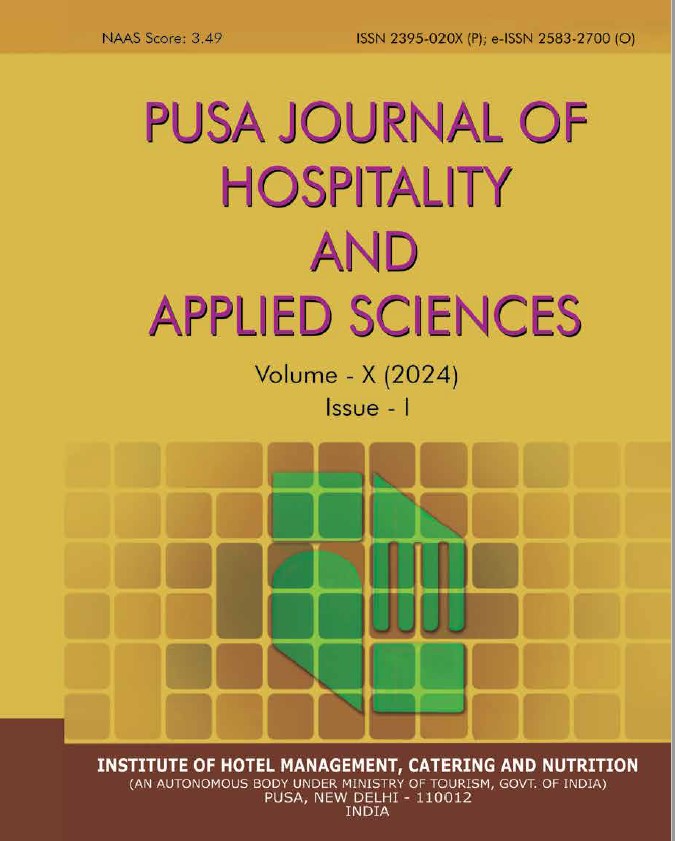A Study Of Consumer Behaviour Towards Products Promoting Health And Sustainability
DOI:
https://doi.org/10.48165/pjhas.2022.8.1.3Keywords:
Consumers, Millennia’s, Healthy food choices, Claims and Labels, Environment friendly, SustainableAbstract
Background: Recent years have seen a transition in consumer’s buying behaviour for foods having better nutrition, transparent claims with more clean processes and ingredients. Objective: This paper aims at understanding the factors that influence consumers’ food buying behaviour, perceptions and healthy food choices. Methodology: Quantitative research was done in restricted cities of India through online media. Information was collected (targeting21-40 years age group) from 470 respondents (64.4% males and 35.6% females). Responses were recorded through an online circulated questionnaire containing 15 close-ended questions, which were statistically analyzed through MS-excel using graphical representations. Results: A greater inclination was seen towards healthier options in staples such as multigrain flour. The survey findings reported that around 34.5% of consumers are taking the product quality claims and source of ingredients seriously, and also consumers do care about the environmental impact of the products, with 83.62% respondents preferring products which are environment friendly and socially responsible. Conclusion: It can be concluded that there has been a considerable shift towards healthier food choices. Companies should focus on strategies to promote healthier choices, clean labels, more transparency and reduce their environment and social burden. Marketing strategies may also be geared towards promotion of products through online platforms since millennia’s, who compromise 48% of work force spend their major time online.
References
Alekhya, P., & Shravanthi, A. R. (2019). Buying behaviour of consumers towards millet based food products in Hyderabad district of Telangana, India. International Journal of Current Microbiology and Applied Sciences, 8(10), 223-236.
Bailey, C., Garg, V., Kapoor, D., Wasser, H., Prabhakaran, D., & Jaacks, L. M. (2018). Food choice drivers in the context of the nutrition transition in Delhi, India. Journal of nutrition education and behavior, 50(7), 675-686.
Chawla, N., & Kumar, B. (2021). E-commerce and consumer protection in India: The emerging trend. Journal of Business Ethics, 1-24. Retrieved from https://doi.org/10.1007/s10551- 021-04884-3
Deloitte Touche Tohmatsu Limited (2021). Know your consumer. Press release. Retrieved from the website: https://www2.deloitte.com/in/en/pages/consumer-business/articles/press-release-know your-consumer.html
Euromonitor (2020). Health and Wellness in India.Market research. Retrieved from the website: https://www.euromonitor.com/health-and-wellness-in-india/report
Grankvist, G., Dahlstrand, U., & Biel, A. (2004). The impact of environmental labelling on consumer preference: Negative vs. positive labels. Journal of Consumer Policy, 27(2), 213-230.
Gupta, R. (2014). India@ 2030: The future of the Indian consumer. Futures, 56, 81-86.
Kearney, J. (2010). Food consumption trends and drivers. Philosophical transactions of the royal society B: biological sciences, 365(1554), 2793-2807.
Lappo, A., Bjørndal, T., Fernandez-Polanco, J., & Lem, A. (2015). CONSUMERS’CONCERNS AND EXTERNAL DRIVERS IN FOOD MARKETS. FAO Fisheries and Aquaculture Circular, (C1102), I.
Mathanghi, S. K., Hemalatha, G., Amutha, S., & Arulmozhichelvan, K. (2013). Food consumption patterns and the nutritional profile of the urban south Indian dwellers. Asian J Dairy Food Res, 32(3), 235-240.
Nandi, R., Bokelmann, W., Gowdru, N. V., & Dias, G. (2017). Factors influencing consumers’ willingness to pay for organic fruits and vegetables: Empirical evidence from a consumer survey in India. Journal of Food Products Marketing, 23(4), 430-451.
Padulosi, S., Mal, B., King, O. I., & Gotor, E. (2015). Minor millets as a central element for sustainably enhanced incomes, empowerment, and nutrition in rural India. Sustainability, 7(7), 8904-8933.
Patil, P. (2019). Recent Trends in Consumer Market and Retail. research journal of social sciences, 10(7).
Prathyusha, N., Lakshmi, V. V., & Manasa, T. (2021). Review on consumer awareness and health benefits about millets. The Pharma innovation journal, 10(6), 777-785.
Rani, N.M., 2020. Millennials and Buying patterns. Studies in Indian Place Names, 40(12), 845- 858.
Rezai, G., Teng, P. K., Mohamed, Z., & Shamsudin, M. N. (2012).Consumers awareness and consumption intention towards green foods. African Journal of Business Management, 6(12), 4496- 4503.
Robinson, R., & Smith, C. (2002). Psychosocial and demographic variables associated with consumer intention to purchase sustainably produced foods as defined by the Midwest Food Alliance. Journal of nutrition education and behavior, 34(6), 316-325.
Sinha, A. K., Johri, G. B., & Rai, S. (2018). Consumer Online Buying Decisions: A Critical Appraisal of Literature. PURUSHARTHA-A journal of Management, Ethics and Spirituality, 10(1), 99-106.
Sonwaney, V., & Chincholkar, S. (2019). Identifying the factors impacting online consumer buying behaviour. International Journal of Scientific and Technology Research, 8(8), 445–456.
The International Food Information Council (2017). Food and Health survey.Retrieved from the website: https://foodinsight.org/2017-food-and-health-survey-a-healthy-perspective-understanding american-food-values/








